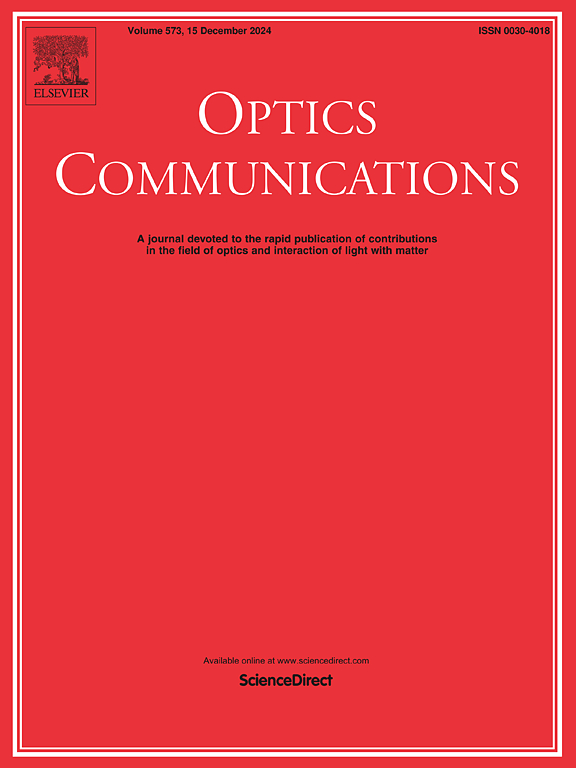Topological insulator-based wideband infrared absorber: Optimization and behaviour prediction using machine learning models
IF 2.5
3区 物理与天体物理
Q2 OPTICS
引用次数: 0
Abstract
A numerical investigation of the multi-layered perfect absorber structure for the wide band infrared spectrum is analyzed using the wide wavelength spectrum. The proposed structure is formed with the topological insulator, metal, and dioxide layers and the different resonator arrays. This structure is investigated over the wavelength spectrum of 0.2 μm–1.6 μm of the spectrum. Different physical parameters have been identified to achieve the optimized results of the wideband absorption spectrum. The proposed absorber structure is investigated over the different incident conditions (TE/TM) modes with wide-angle values ranging from 00 to 800. The proposed structure is polarisation non-sensitive up to 700 of the incident angle. The structure is also investigated for the different resonator arrays consisting of circular, squared and rectangular resonators. The effect of the different unit cells was also examined to identify the optimized size of the wideband absorber structure. The behaviour of the overall structure is predicated by the different machine learning models such as kNN, Random Forest, Neural Network, Gradient Boosting and AdaBoost. The machine learning parameters such as MSE, RMSE, MAE, MAPE, and R2 are compared to identify suitable models for accurately predicting the absorption spectrum. The R2 value is the minimum on the Neural network of up to 0.83 and the maximum of up to 0.96 in all four other models. The scatter plots and these values can help identify the suitable model that generates the prediction of the absorption spectrum more accurately. The proposed results in this manuscript can be helpful for various sensing and quantum dot-based photonics applications.
基于拓扑绝缘体的宽带红外吸收体:使用机器学习模型的优化和行为预测
利用宽波长光谱分析了多层完美吸收结构对宽波段红外光谱的影响。所提出的结构由拓扑绝缘体、金属层和二氧化二氮层以及不同的谐振器阵列组成。在0.2 μm - 1.6 μm的光谱范围内对该结构进行了研究。确定了不同的物理参数,以获得宽带吸收光谱的优化结果。在广角值从00到800的不同入射条件(TE/TM)模式下,对所提出的吸收结构进行了研究。所提出的结构是偏振不敏感的,直到700入射角。本文还研究了由圆形、方形和矩形谐振器组成的不同谐振器阵列的结构。还考察了不同单元胞的影响,以确定宽带吸收结构的最佳尺寸。整体结构的行为由不同的机器学习模型(如kNN、随机森林、神经网络、梯度增强和AdaBoost)来预测。比较了机器学习参数MSE、RMSE、MAE、MAPE和R2,以确定准确预测吸收光谱的合适模型。在神经网络上R2值最小,可达0.83,在其他四种模型中R2值最大,可达0.96。散点图和这些值可以帮助确定合适的模型,从而更准确地预测吸收光谱。本文所提出的结果可用于各种传感和基于量子点的光子学应用。
本文章由计算机程序翻译,如有差异,请以英文原文为准。
求助全文
约1分钟内获得全文
求助全文
来源期刊

Optics Communications
物理-光学
CiteScore
5.10
自引率
8.30%
发文量
681
审稿时长
38 days
期刊介绍:
Optics Communications invites original and timely contributions containing new results in various fields of optics and photonics. The journal considers theoretical and experimental research in areas ranging from the fundamental properties of light to technological applications. Topics covered include classical and quantum optics, optical physics and light-matter interactions, lasers, imaging, guided-wave optics and optical information processing. Manuscripts should offer clear evidence of novelty and significance. Papers concentrating on mathematical and computational issues, with limited connection to optics, are not suitable for publication in the Journal. Similarly, small technical advances, or papers concerned only with engineering applications or issues of materials science fall outside the journal scope.
 求助内容:
求助内容: 应助结果提醒方式:
应助结果提醒方式:


